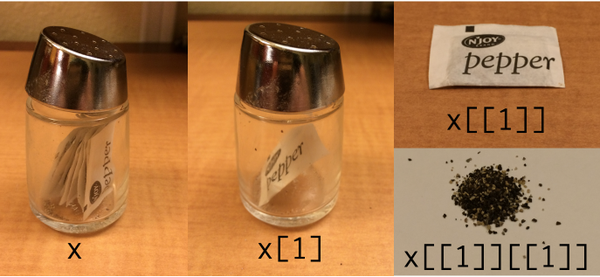An important lesson you should learn early on is that there are multiple ways to do things in R. For example, to generate the first five integers we note that 1:5 and seq(1,5) return the same result. There are also multiple ways to access variables in a data frame. R has three: [, [[ and $, but why?

Subset with [
When you take a subset of an object the returned object will have the exact same datatype as the original object. The subset of a vector, list and dataframe are respectively a vector, list and dataframe. You can subset variables in two ways:
- Subset named variable(s): When you want subset named variables you can take a subset by the variable names. this operator expects a
charactervector with a subset of the variable name(s).murders["population"] - Subset variable(s) by indices: If you want to take a subset by indices (position of the variables) you can use the same operator with a
numericvector containing the indices of the variables. In this case we subset the fourth column, which is population. (see colnames(murders))murders[4]
Extract one variable with [[
When you extract one variable it wont have the same datatype as the original object. This is because are unpacking the object. For example: When you extract a variable from a dataframe you get a vector with the column data. You can extract variables in two ways:
- Extract named variable: When the variable you want to extract is named (named list, dataframe column name) you can extract it by name. The name has to have the
characterdatatype.murders[["population"]] - Extract variable by index: You can also extract the variable by index (position in the list or dataframe). The index has to have the
numericdatatype. In this case we extract the fourth column, which is population. (see colnames(murders))murders[[4]]
Extract one named variable with $
In the case where you want extract one named variable you can use the $ operator instead of [[. The only difference is that this method is six times shorter ($ vs [[""]]), this operator doesn’t expect a numeric or character. Instead you can acces the variable the the same way as a normal variable.
murders$population
Exercise
-
Create a dataframe
abb_dfcontaining one column named “abb”. This column should contain the abbreviations column from the murders dataset. To do this you will have to extract the abbreviations column and then create a new dataframe using thedata.framefunction. Read the help pagehelp(data.frame)to see how you can specify column names. -
Use the accessor
$to extract the state abbreviations variable. Assign the result toa. -
Use the square brackets
[[to extract the state abbreviations variable. Assign the result tob. -
Use the
identicalfunction to determine ifaandbare equal.
NOTE
We have already loaded in the murders dataframe for you.